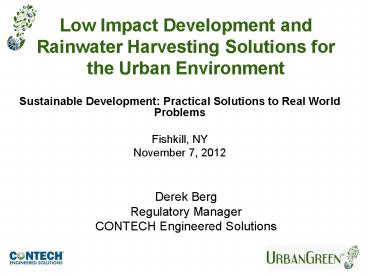Sustainable Development: Practical Solutions to Real World Problems - PowerPoint PPT Presentation
1 / 22
Title:
Sustainable Development: Practical Solutions to Real World Problems
Description:
Low Impact Development and Rainwater Harvesting Solutions for the Urban Environment Sustainable Development: Practical Solutions to Real World Problems – PowerPoint PPT presentation
Number of Views:147
Avg rating:3.0/5.0
Title: Sustainable Development: Practical Solutions to Real World Problems
1
Low Impact Development and Rainwater Harvesting
Solutions for the Urban Environment
- Sustainable Development Practical Solutions to
Real World Problems - Fishkill, NY
- November 7, 2012
Derek Berg Regulatory Manager CONTECH Engineered
Solutions
2
What is Low Impact Development?
- Design philosophy for managing stormwater
- Mimic predevelopment hydrology (modeled after
nature) - Reduce, infiltrate, re-use, evaporate, filter,
detain runoff close to its source
Photo Seattle SEA Streets Project
3
5 Principles of LID
- Conserve natural areas
- Minimize development impact on hydrology
- Maintain runoff rate and duration from the site
- Use integrated stormwater management practices
- Implement pollution prevention, proper
maintenance and public education programs
4
Updated NYS Stormwater Standards
5 Step Design/Planning Process
- Site planning to preserve natural features and
reduce impervious cover - Calculate of the water quality volume
- Incorporate green infrastructure and standard
SMPs with Runoff Reduction Volume (RRv) capacity
(Infiltration, rainwater harvesting, porous
pavers) - Use standard SMPs, where applicable, to treat the
water quality volume not addressed by green
infrastructure techniques and standard SMPs with
RRv capacity (biofiltration, filtration) - Design volume and peak rate control practices
where required. (Detention)
5
LID Regulatory Hierarchy
6
Surface Infiltration ChamberMaxx
7
Surface Infiltration Grass Paver
8
Sub-Surface Infiltration
- Retention
- Maintain predevelopment hydrology
- Preserve Land Area
- Pretreatment Recommended
- Detention
- Traditional Design Practice
- Conditions not suitable for infiltration
- Reduce Runoff Rate
Metal
Plastic
Concrete
9
Subsurface Infiltration CDS and Perf Pipe
10
Turnkey Rainwater Harvesting Solutions
- Rainwater Harvesting
- Above ground storage
- Below ground storage
- Metal
- Steel Reinforced Polyethylene
- Concrete
- Pump, Treatment, Control Systems
- Complete Systems
11
Rainwater Harvesting Two Perspectives
Conservation Focus Stormwater Focus
Primary Goal Reduced municipal demand Eliminate runoff (pollution prevention)
Secondary Benefits Reduce SW Runoff, Energy, CO2 Conservation, Energy, CO2
Catchment Area Maximize, to Increase Supply Minimize, to Reduce Supply
Water Usage Minimize and Conserve Find Reuse Applications
Seasonal Challenge Dry Season not enough rain Wet Season too much rain
Cistern Goal Keep it full Empty it quickly
Economic ROI Negative external costs not included in market price of water Positive best LID solution in many cases
12
Rainwater Harvesting
13
UrbanGreen BioFilter
- Innovative tree box filter design
- Incorporates bioretention media filtration
- Combines biological, chemical physical
treatment processes
14
UrbanGreen BioFilter
Operation Increasing Flow
- Two stage treatment
- Low flows treated by biofiltration
- Higher flows treated by cartridge based media
filtration - Two 27 StormFilter cartridges
- Cartridges treat 22.5 GPM each
3
4
15
McNichols Office Bldg. Roanoke, VA
16
Sub-Surface Filtration StormFilter
17
StormFilter Vault
18
StormFilter Media
PhosphoSorb Perlite CSF Leaf Media ZPG
Sediments
Oil and Grease
Soluble Metals
Organics
Nutrients
Total Phosphorus
19
Filtration and Infiltration
20
Treatment and Detention
Volume Storage Treatment Chain
21
UrbanGreen Building Blocks
- Hydrodynamic Separation
- Stand Alone Treatment
- Redevelopment
- Retrofit
- LID Pretreatment IMP
- Surface Infiltration
- Subsurface Infiltration
- Rainwater Harvesting
VortSentry HS
VortSentry
22
Questions???
- Derek Berg
- E dberg_at_conteches.com
- Ph 207-885-9830

